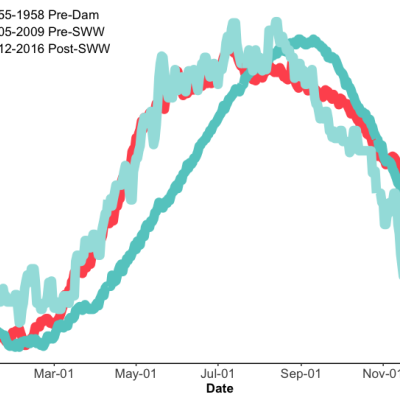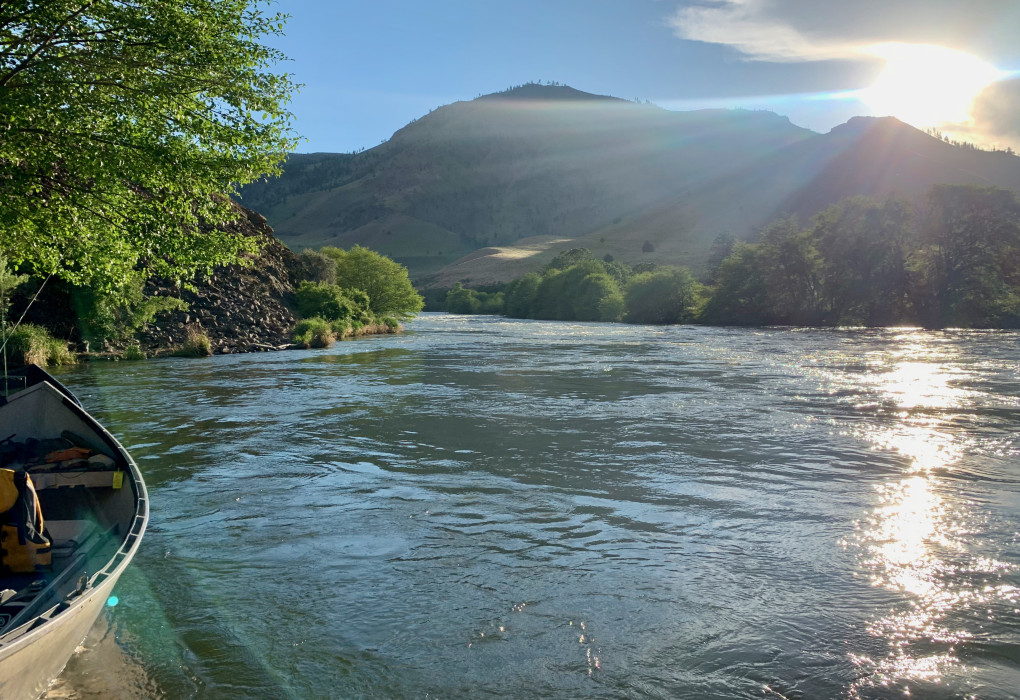Summarizing the Lower Deschutes Stakeholder Process
For the past year, Native Fish Society has been a convening member of a stakeholder group that has examined water temperatures in the lower Deschutes River. One of the goals of this group was to try to identify ways to address some of the water quality issues in the lower Deschutes that had not already been examined and modeled by the Fish Committee.*
Things We Learned During the Process
One of the key topics we discussed was the regulations the Federal Energy Regulatory Commission (FERC) has in place that determine the management of the Pelton Round Butte Dam Complex. These regulations limit the flexibility of Portland General Electric and the Confederated Tribes of Warm Springs in altering the way they manage temperature and flows at Pelton Round Butte. Some of the key limitations include:
The Pelton Round Butte complex is a modified “run-of-river” dam (± 10%), meaning that water flowing into the reservoir has to be sent downstream, it can’t be stored for later power generation and has a very limited ability to serve as flood control.
Regulating the water temperature so that it is within 0.25 °F of what the temperature would be if the dams did not exist. Before the installation of the selective water withdrawal (SWW) tower, water temperatures at the Madras USGS gage were regularly higher than what they should have been in the late summer if the project didn’t exist (see figure below).
The team also reviewed water release scenarios from the SWW tower that had already been modeled and had a brainstorming session to try to come up with alternative scenarios that had not yet been modeled. Special attention was given to a “winter blend” scenario in which more water would be released from the bottom of the reservoir in the winter, but modeling revealed that there would be virtually no change as a result of this option, as the reservoir is well-mixed during the winter months.
After determining that changes to SWW operations were unlikely to have much effect on the lower river, other options for management were explored by the group. Over several meetings, it was determined that there were three actions the group was interested in moving forward on.
The Path Forward
The three actions that the group committed to are:
Stream and Riparian Restoration. Trout Unlimited conducted a study of lower Deschutes tributaries to find those that would provide the greatest cooling benefit if they were revegetated. This study identified 15 sites of at least 0.5 mile in length in Trout Creek (6 sites), Bakeoven Creek (4 sites), and Buck Hollow Creek (5 sites), as well as an additional potential site in the lower 0.6 mile of the Warm Springs River. There was a significant interest from the group in pursuing this work, which will be led by Trout Unlimited and Native Fish Society.
Creating a Lower Deschutes Data Repository. With several different agencies collecting data on the lower Deschutes, it can be difficult to locate a specific piece of information. The goal of this project is to create one website any member of the public can go to and then be directed to the most recent data and reports on the lower Deschutes. An additional goal is to prepare a white paper summarizing the current state of knowledge on the lower river and identify any gaps that need further study. A number of stakeholder members were interested in moving forward with this work. This project will be led by the Native Fish Society.
Purchasing Instream Water Rights. ODFW will work with the licensees and the Deschutes River Conservancy to identify water rights available for purchase that will actually result in more water staying in the river. After the initial analysis is completed, stakeholders will get a chance to review the recommendations and make suggestions.
Final Thoughts
Everyone had hoped that the group would be able to identify a novel approach to address water temperature issues in the lower Deschutes, but no clear solution emerged. The biggest takeaway from the stakeholder process was how dedicated to and concerned everyone is for the lower Deschutes River. A couple of those who took part weren’t happy that the group wasn’t able to change the management of the SWW, but everyone expressed at least some interest in moving forward with the three actions that were identified during the process. Improving conditions in the lower Deschutes will be an ongoing effort, and Native Fish Society is proud to be taking a leadership role wherever possible.
*The Fish Committee members are: Portland General Electric and the Confederated Tribes of Warm Springs (the project owners), Oregon Department of Fish and Wildlife, CTWS Natural Resources, US Fish and Wildlife Service, NOAA Fisheries, Bureau of Indian Affairs, US Forest Service, US Bureau of Land Management, Oregon Department of Environmental Quality, Trout Unlimited, WaterWatch, American Rivers, The Freshwater Trust, Native Fish Society, and came about through the relicensing of the Pelton Round Butte dam complex in 2005. The purpose of the Fish Committee is to oversee the licensee’s development and implementation of study plans, reports, facility designs, and operating and implementation plans. All the NGOs together have only one vote.

